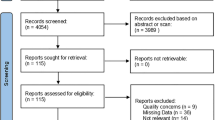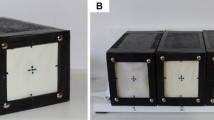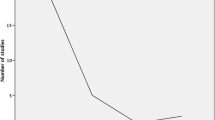Abstract
Background
Clinical robotic surgery systems do not currently provide haptic feedback because surgical instrument interactions are difficult to measure and display. Our laboratory recently developed a technology that allows surgeons to feel and/or hear the high-frequency vibrations of robotic instruments as they interact with patient tissue and other tools. Until now, this type of feedback had not been carefully evaluated by users.
Methods
We conducted two human-subject studies to discover whether surgeons and non-surgeons value the addition of vibration feedback from surgical instruments during robotic surgery. In the first experiment, 10 surgeons and 10 non-surgeons (n = 20) used an augmented Intuitive da Vinci Standard robot to repeatedly perform up to four dry-lab tasks both with and without haptic and audio feedback. In the second experiment, 68 surgeons and 26 non-surgeons (n = 94) tested the same robot at a surgical conference: each participant spent approximately 5 min performing one or two tasks.
Results
Almost all subjects in both experiments (95 and 98 %, respectively) preferred receiving feedback of tool vibrations, and all subjects in the second experiment thought it would be useful for surgeons to have the option of such feedback. About half of the subjects (50, 60 %) preferred haptic and audio feedback together, and almost all the rest (45, 35 %) preferred haptic feedback alone. Subjects stated that the feedback made them more aware of tool contacts and did not interfere with use of the robot. There were no significant differences between the responses of different subject populations for any questions in either experiment.
Conclusions
This study illustrates that both surgeons and non-surgeons prefer instrument vibration feedback during robotic surgery. Some participants found audio feedback useful but most preferred haptic feedback overall. This strong preference for tool vibration feedback indicates that this technology provides valuable tactile information to the surgeon.










Similar content being viewed by others
References
Guthart GS, Salisbury JK (2000) The IntuitiveTM telesurgery system: overview and application. Proceedings of IEEE International Conference on Robotics and Automation. doi:10.1109/ROBOT.2000.844121
DiMaio S, Hanuschik M, Kreaden U (2011) The da Vinci surgical system. In: Rosen J, Hannaford B, Satava RM (eds) Surgical robotics: systems application and visions. Springer, New York, pp 199–217
Okamura AM (2009) Haptic feedback in robot-assisted minimally invasive surgery. Curr Opin Urol. doi:10.1097/MOU.0b013e32831a478c
Johansson RS, Flanagan JR (2009) Coding and use of tactile signals from the fingertips in object manipulation tasks. Nat Rev Neurosci. doi:10.1038/nrn2621
Bholat OS, Haluck RS, Murray WB, Gorman PJ, Krummel TM (1999) Tactile feedback is present during minimally invasive Surgery. J Am Coll Surg. doi:10.1016/S1072-7515(99)00184-2
Intuitive Surgical Inc. (2013) Annual Report 2013, Delaware, USA, p. 46
van der Meijden OA, Schijven MP (2009) The value of haptic feedback in conventional and robot-assisted minimal invasive surgery and virtual reality training: a current review. Surg Endosc. doi:10.1007/s00464-008-0298-x
Bethea BT, Okamura AM, Kitagawa M, Fitton TP, Cattaneo SM, Gott VL et al (2004) Application of haptic feedback to robotic surgery. J Laparoendosc Adv Surg Tech A. doi:10.1089/1092642041255441
Simorov A, Otte RS, Kopietz CM, Oleynikov D (2012) Review of surgical robotics user interface: what is the best way to control robotic surgery? Surg Endosc. doi:10.1007/s00464-012-2182-y
Gutt CN, Oniu T, Mehrabi A, Kashfi A, Schemmer P, BÃŒchler MW (2004) Robot-assisted abdominal surgery. Br J Surg. doi:10.1002/bjs.4700
Hagen ME, Meehan JJ, Inan I, Morel P (2008) Visual clues act as a substitute for haptic feedback in robotic surgery. Surg Endosc. doi:10.1007/s00464-007-9683-0
Kitagawa M, Dokko D, Okamura AM, Yuh DD (2005) Effect of sensory substitution on suture-manipulation forces for robotic surgical systems. J Thorac Cardiovasc Surg. doi:10.1016/j.jtcvs.2004.05.029
Culjat M, King CH, Franco M, Bisley J, Grundfest W, Dutson E (2008) Pneumatic balloon actuators for tactile feedback in robotic surgery. Ind Robot. doi:10.1108/01439910810893617
King C-H, Culjat MO, Franco ML, Lewis CE, Dutson EP, Grundfest WS, Bisley JW (2009) Tactile feedback induces reduced grasping force in robot-assisted surgery. IEEE Trans Haptics. doi:10.1109/ToH.2009.4
Wagner CR, Howe RD (2007) Force feedback benefit depends on experience in multiple degree of freedom robotic surgery task. IEEE Trans Robot. doi:10.1109/Tro.2007.904891
Puangmali P, Althoefer K, Seneviratne LD, Murphy D, Dasgupta P (2008) State-of-the-art in force and tactile sensing for minimally invasive surgery. IEEE Sens J. doi:10.1109/JSEN.2008.917481
Madhani AJ, Niemeyer G, Salisbury JK (1998) The Black Falcon: a teleoperated surgical instrument for minimally invasive surgery. Proceedings of IEEE/RSJ International Conference on Intelligent Robots and Systems. doi:10.1109/IROS.1998.727320
Mahvash M, Okamura A (2007) Friction compensation for enhancing transparency of a teleoperator with compliant transmission. IEEE Trans Robot. doi:10.1109/TRO.2007.909825
Mahvash M, Gwilliam J, Agarwal R, Vagvolgyi B, Su L-M, Yuh DD, Okamura AM (2008) Force-feedback surgical teleoperator: controller design and palpation experiments. Proceedings of IEEE Symposium on Haptic Interfaces for Virtual Environments and Teleoperator Systems. doi:10.1109/HAPTICS.2008.4479994
Culjat MO, Bisley JW, King C, Wottawa C, Fan RE, Dutson EP, Grundfest WS (2011) Chapter 18: tactile feedback in surgical robotics. In: Rosen J, Hannaford B, Satava RM (eds) Surgical robotics: system applications and visions. Springer, New York City, pp 449–468
Myles KP, Binseel MS (2009) Chapter 19: exploring the tactile modality for HMDs. In: Rash CE, Russo MB, Letowski TR, Schmeisser ET (eds) Helmet-mounted displays: sensation, perception and cognition issues. SPIE Press, Bellingham, pp 849–876
Kontarinis D, Howe RD (1995) Tactile display of vibratory information in teleoperation and virtual environments. Presence: Teleoperators and Virtual Environments 4(4):387–401
McMahan W, Kuchenbecker KJ (2009) Haptic display of realistic tool contact via dynamically compensated control of a dedicated actuator. Proceedings of IEEE/JRS International Conference on Intelligent Robots and Systems. doi:10.1109/IROS.2009.5354607
McMahan W, Romano JM, Rahuman AMA, Kuchenbecker KJ (2010) High frequency acceleration feedback significantly increases the realism of haptically rendered textured surfaces. Proceedings of IEEE Haptics Symposium. doi:10.1109/HAPTIC.2010.5444665
McMahan W, Gewirtz J, Standish D, Martin P, Kunkel J, Lilavois M, Wedmid A, Lee DI, Kuchenbecker KJ (2011) Tool contact acceleration feedback for telerobotic surgery. IEEE Trans Haptics. doi:10.1109/TOH.2011.31
Bark K, McMahan W, Remington A, Gewirtz J, Wedmid A, Lee DI, Kuchenbecker KJ (2012) In vivo validation of a system for haptic feedback of tool vibrations in robotic surgery. Surg Endosc. doi:10.1007/s00464-012-2452-8
Peters J, Fried GM, Swanstrom LL, Soper NJ, Sillin LF, Schirmer B, Hoffman K, SAGES FLS Committee (2004) Development and validation of a comprehensive program of education and assessment of the basic fundamentals of laparoscopic surgery. Surgery. doi:10.1016/S0039-6060(03)00156-9
McMahan W, Gomez ED, Chen L, Bark K, Nappo JC, Koch EI, Lee DI, Dumon K, Williams N, Kuchenbecker KJ (2013) A practical system for recording instrument interactions during live robotic surgery. J Robot Surg. doi:10.1007/s11701-013-0399-y
Gomez ED, Bark K, Rivera C, McMahan M, Remington A, Lee DI, Williams NN, Kenric MM, Dumon KR, Kuchenbecker K (2012) Construct validity of instrument vibrations as a measure of robotic surgical skill. J Am Coll Surg 215(3):S119–S120
Lee AY (2001) The mere exposure effect: an uncertainty reduction explanation revisited. Per Soc Psychol Bull. doi:10.1177/01461672012710002
Acknowledgments
This project was funded by a 2011 Translational Research Award (no grant number) from the Wallace H. Coulter Foundation. The da Vinci robot and instruments were donated by Intuitive Surgical, Inc. Data were collected using the REDCap online survey collection system. The authors would also like to thank Karlin Bark, Anna Brzezinski, Delara Ghanei, Ernest D. Gomez, Michael Gosselin, Jennifer Hui, Eza Koch, William McMahan, John Nappo, and Neel Shah for their contributions to the reported studies.
Disclosures
Jacqueline K. Koehn has no conflicts of interest or financial ties to disclose. Professor Katherine J. Kuchenbecker co-invented the vibration feedback technology evaluated in this paper. This invention is described in pending patent applications that have not been licensed to any company. Professor Kuchenbecker has no other conflicts of interest or financial ties to disclose.
Author information
Authors and Affiliations
Corresponding author
Rights and permissions
About this article
Cite this article
Koehn, J.K., Kuchenbecker, K.J. Surgeons and non-surgeons prefer haptic feedback of instrument vibrations during robotic surgery. Surg Endosc 29, 2970–2983 (2015). https://doi.org/10.1007/s00464-014-4030-8
Received:
Accepted:
Published:
Issue Date:
DOI: https://doi.org/10.1007/s00464-014-4030-8




